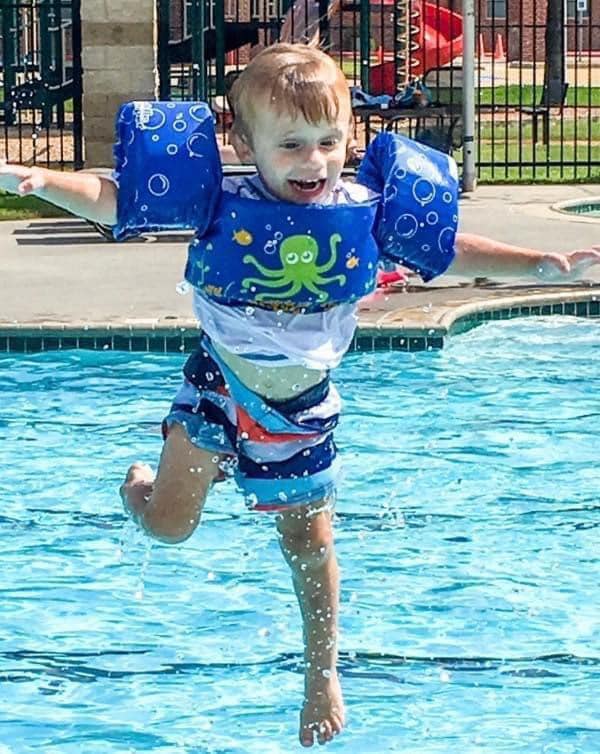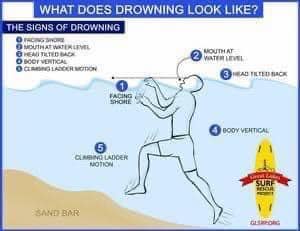

We can learn from the tragic experiences of others. I never knew these devices had such a bad track record. Several of my grandchildren have used them. Praise God they are all learning to swim now.The following information comes from:
Judah Brown Projectn
The puddle jumper. It’s the flotation device moms love. They are cute. They look fun and inviting and they give our kids independence in the water. We think they keep our kids safe, but do they really?
This post is extremely hard for me. I was that mom who put my beautiful 3-year-old baby boy in one of these devices. The packaging told me it would help him stay safe. Other moms told me it would help him stay safe. All I wanted to do was to keep him safe. That’s it. That was my sole reason for buying and using this device.
I put it on him every time we went to water (which was usually a pool).
I learned after my beautiful baby boy drowned that the unintended things he learned while using this device were a major factor in his accident.
This is why…
1) Puddle jumpers automatically put children in a vertical position in the water. They teach a head up and arched and feet down position and that is also known as the drowning position. Puddle jumpers teach children muscle memory for that position so that when they get in water, they will automatically go vertical, whether they have the device on or not. This makes drowning faster.
2) Puddle Jumpers can teach children to bicycle their arms and legs in order to propel through the water. This expends huge amounts of energy and contributes significantly to drowning incidents because it cannot be sustained for very long for young kids. They have the wrong body proportions under the age of 5 to stay in a treading position for more than around 30 seconds before they submerge and begin to drown.
3) Puddle Jumpers can and often do prevent kids from learning to reach their arms out in front of them for any swimming stroke and from putting their heads in the water to help get into a horizontal (swimming and breathing position) in the water. Ask swim instructors and they will tell you that they can spot a puddle jumper kid anywhere and that it takes these kids twice as long to learn to swim on their own because of the poor body positioning that these devices teach the kids.
4) This one applies to ANY flotation device used in pools frequently with young children. ANY flotation device can create a false sense of security/safety for the child. The child thinks they can swim because they have built confidence in the water with the device, using it consistently during swim times. At young ages they don’t know how their own bodies react in the water (without a flotation device on) because they have been wearing them every time they get into a pool. They then don’t make the connection that the device is what is keeping them floating and not themselves.
The way they see it, they have always been able to float and do so with very little effort each time they play in the water, so they should be able to do that every time. They don’t see that it’s the device that is keeping them up and that without it, they can’t swim or float.
So, when the opportunity arises for them to get into water when they aren’t supposed to be in it, when you are momentarily distracted, they are much more likely to do so without the device, thinking they can swim on their own, when they really can’t. That’s when the false sense of confidence can cause a drowning.
70% of all child drownings happen during non swim times, when kids aren’t expected to be in or near the water. That could be when you are getting snacks ready for them or tending to another child or when you are done with swimming for the day and don’t expect them to be near the water anymore.
We have story after story of kids who survived their drownings (talking about not just puddle jumpers but any flotation device) and how they didn’t think they needed it to swim and that’s why they went in without it. From the kid’s own mouths.
5) ANY flotation device can create a false sense of security for adults. Adults tend to not be as vigilant around the water when they put their kids in these devices. So, as an example, during a break when a parent might be attending to another child, their little one may have their device off temporarily and because the parent has trained themselves not to have to be as vigilant, they have a lapse in supervision for a few seconds. In that time, the little one can end up in the pool without the device that holds them up in the water and can drown. Drowning in this age group only takes 20-30 seconds. It’s fast and it’s silent. It doesn’t look like it does on TV.
6) Puddle Jumpers are coast guard approved but you need to know that the coast guard only evaluates and approves devices for use on a boat, in open water. They do not even evaluate ANY devices for use anywhere else, including pools.
Pools are controlled water. Open water is uncontrolled and unexpected things can and do happen there with frequency. This is why anyone who goes to open water should have a life jacket on. But this is not the case with pools.
Pools are where kids should be learning their limits in the water, developing a healthy respect for it, learning to save themselves and then to swim in it, practicing their skills there. That can’t be done when they are always in a device.
My son thought he could swim because I put this device on him during swim times and he learned and adopted all of the points above. He went to the water without his puddle jumper when I looked over at the deep end of the pool to make sure my other kids were doing ok. That’s all the time he needed to sneak back to the water without me and without his device.
And I inadvertently taught him the confidence to do that by always using the device with him and encouraging his independence with it.
I should have taught him what his own body could and couldn’t do in the water. I should have had one on one touch supervision with him in and around the water until he could swim. I should have gotten him into lessons that would teach him what to do if he ever fell into the water on his own, instead of the mommy and me lessons I had him in.
My son drowned. He died. He was only gone from my sight for a minute or two.
It only takes 30 seconds.
Why not puddle jumpers? Because your child’s life is not worth the risk that using these devices can and do pose.
Do you have a puddle jumper or flotation device story? Would you share below?

Thank you for sharing! We don’t have any wearable floatation devices, for exactly these reasons. God bless you!